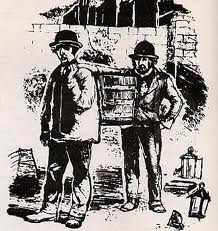The Radio Lab recently featured a podcast called “Poop Train.” Guaranteed to grab your attention, the title referred to a system used by cities to eliminate human waste water. Surprisingly, we learn from the podcast that it wasn’t until the 1980s that New York City stopped dumping treated human waste into the ocean. Gradually, the treatment facilities improved and the resulting sludge was transported to farmers around the U.S. to dress their fields. Because the costs were so high to transport the stuff, sludge is now being kept nearer New York City, awaiting someone to innovate an inexpensive way to transform human waste to agricultural manure on a scale that makes economic sense.
The idea of spreading human waste on fields that produce food for human consumption, although elegantly circular, if off-putting to some. To others, manure is manure. Entrepreneurs in London during the nineteenth century felt the same.

When the London Embankment project was underway, men known as Gong Farmers, transported human waste to farmers outside London for use on agricultural land. When the railroads came to London, Joseph Balzalgette, the engineer who designed the Embankment sewerage system in the mid-1800s, suggested transporting waste on trains to farmers outside London. The history of this enterprise is told in a book by Stephen Halliday called The Great Stink (http://www.amazon.com/The-Great-Stink-London-Bazalgette/dp/0750925809/ref=sr_1_1?ie=UTF8&qid=1381715168&sr=8-1&keywords=great+stink+of+london). Maybe it’s time to get the topic back on the agenda for urban planners, big stink or not.